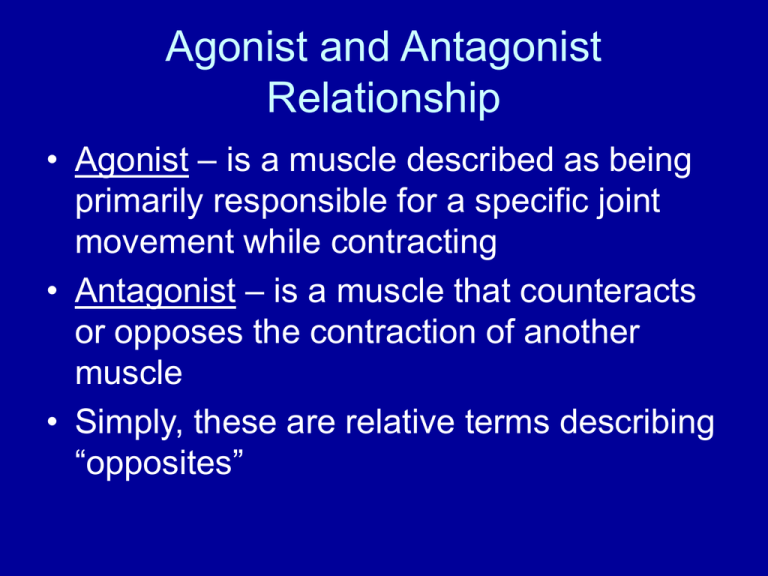Elbow and Radioulnar Joint Movements
advertisement

Agonist and Antagonist Relationship • Agonist – is a muscle described as being primarily responsible for a specific joint movement while contracting • Antagonist – is a muscle that counteracts or opposes the contraction of another muscle • Simply, these are relative terms describing “opposites” • If an agonist muscle is considered a concentric contractor for a movement then the antagonist muscle is the eccentric contractor for the same movement. • Generally, concentric and eccentric contractions do not occur at the same time for a given movement. • What determines which one is working is the purpose of movement, acceleration (speeding-up) or deceleration (slowingdown). • Examples Steps to determine contraction type 1. Identify the joint movement 2. Identify the agonist (concentric contractor) and antagonist (eccentric contractor) for the joint movement 3. Determine if the movement is speeding-up (accelerating) or slowing-down (decelerating) - If speeding-up then agonist working concentrically If slowing-down then antagonist working eccentrically Elbow and Radioulnar Joint Movements • elbow - flexion and extension • Radioulnar (forearm) - pronation and supination Biceps Brachii* O: Long Head – supraglenoid tubercle above the superior lip of glenoid fossa Short Head – coracoid process and upper lip of glenoid fossa I: Tuberosity of radius and bicipital aponeurosis A: Flexion of elbow, supination of forearm (radioulnar), weak flexion of shoulder, and weak abduction of shoulder Brachialis O: Distal ½ anterior shaft of humerus I: Coronoid process of ulna A: True flexion of the elbow Brachioradialis O: Distal 2/3 of lateral condyloid (supracondyloid) ridge of humerus I: Lateral surface distal end of radius at the styloid process A: Flexion of elbow, pronation from supinated position to neutral (thumb up), supination from pronated position to neutral Triceps brachii O: Long head – infraglenoid tubercle below inferior lip of glenoid fossa of scapula Lateral head – upper ½ posterior surface of humerus Medial head – distal 2/3 of posterior surface of humerus I: Olecranon process of ulna A: All heads: extension of elbow Long head: extension, adduction, and horizontal abduction of shoulder Anconeus O: Posterior surface of lateral condyle of humerus I: Posterior surface of olecranon process and proximal ¼ of ulna A: extension of elbow Pronator teres O: Distal part of medial condyloid ridge of humerus and medial side of proximal ulna I: Middle third of lateral surface of radius A: Pronation of forearm (radioulnar) and weak flexion of elbow Pronator quadratus O: Distal fourth anterior side of ulna I: Distal fourth anterior side of radius A: Pronation of forearm Supinator O: Lateral epicondyle of humerus and neighboring posterior part of ulna I: Lateral surface of proximal radius just below the head A: Supination of forearm Ligaments of the Elbow • Radial collateral ligament – provides lateral stability of the elbow; resists lateral displacement of elbow • Ulnar collateral ligament – provides medial stability of the elbow; resists medial displacement of elbow • Annular ligament – stabilizes the head of radius to the ulna and allows smooth articulation with the ulna Radial Collateral Ligament Ulnar Collateral Ligament Annular Ligament Introduction to Linear Kinetics • Linear Kinetics – the study of linear forces associated with motion (ex. force, momentum, inertia). • Linear Kinematics – the study of linear motion. • Force = mass x acceleration Force → Acceleration → Velocity → Displacement • Vector – is a quantity that has both magnitude (how much) and direction. • Used as a measuring tool for linear variables which have both magnitude and direction. • Illustrated by an arrow where the tip represents direction and the length representing magnitude. • Muscle Force – can be measured with vectors, since muscle force pulls on bone in a linear fashion. • Vector composition – is a process of determining a single vector (usually called resultant) from two or more vectors. • Vectors can typically be analyzed as having horizontal (x) and vertical (y) components. • In this case, these perpendicular component vectors can be used to form a right triangle. • A common trigonometric principle used is the Pythagorean theorem, where A2 + B2 = C2. θ C A θ B • Furthermore, the following equations are derived from the Pythagorean theorem: sin θ = opposite / hypotenuse cos θ = adjacent / hypotenuse tan θ = opposite / adjacent θ C A θ B Sample Problem If the muscle force generated by the biceps brachii is 20 lbs, how much rotary (y) force is generated by the muscle? How much dislocating (x) force? Known: angle of pull = 45 degrees Muscle force (resultant) = 20 lbs Unknown: rotary (y) force dislocating (x) force Rotary force (y) calculation: sin θ = opposite / hypotenuse sin 45 = rotary (y) / 20 lbs sin 45 x 20 lbs = rotary (y) rotary (y) = 14.14 lbs Dislocating force calculation: cos θ = adjacent / hypotenuse cos 45 = dislocating (x) / 20 lbs cos 45 x 20 lbs = dislocating (x) dislocating = 14.14 lbs Pythagorean Check A2 + B2 = C2 (rotary force)2 + (dislocating force)2 = (muscle force)2 (14.14 lbs)2 + (14.14 lbs)2 = (muscle force)2 399.88 lbs = (muscle force)2 √ 399.88 = muscle force 20 lbs = muscle force







